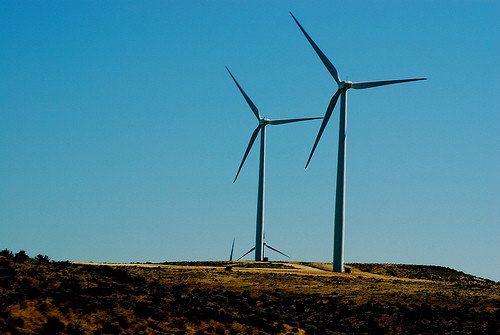
The bankruptcy of the solar energy company Solyndra not only cost taxpayers over half a billion, it also dealt a serious blow to the nation's adoption of clean energy. The Obama administration's attempt to jump-start the clean energy sector by picking favorites begs the question whether the federal government, instead of picking winners and losers in the battle to transform the nature of America's energy use, should, instead, step back, enable adequate oversight and set the stage for the market to decide for itself.
The electric power sector contributes about 40 percent of the nation's total carbon dioxide emissions, according to the Department of Energy's Energy Information Agency (EIA). That total is greater than any other sector of the U.S. economy, including transportation. Deregulation, or opening the nationwide electricity sector to competition -- a long-forsaken policy at the federal level -- deserves fresh consideration.
Many American utilities have long operated as virtual monopolies, so much so that their captive markets are often embedded into their own names. Georgia Power, Southern California Edison, Detroit Edison, Nevada Power -- the list is long. Aspiring electricity providers have traditionally been barred, first by federal regulations, and then by certain states, from entering the bastions of incumbents. In such an un-competitive environment, customers are often reduced to "rate-payers" with little-to-no choice when it comes to their energy services or suppliers. Guaranteed revenue streams have made utilities averse to innovation.
Contrast the situation in the U.S. with that in Europe. The European Union mandated liberalization -- their term for deregulation, or electricity competition -- to come into effect throughout the region four years ago. The passage of the E.U. mandate released competitive forces. The looming threat of someone like the French utility, EDF, making a move towards Italy in an effort to grab a chunk of its customers motivated the Italian utility, Enel, to roll out the world's largest grid modernization project in 2001. Enel now has over 32 million smart meters operational in Italy, and offers a variety of customer-care services. (Full disclosure: From 2000-2006 I worked for Echelon Corporation, a company that provided Enel with communications technology for its smart grid project.) Installing the meters cost Enel 2 billion euros in total (slightly less than $2 billion in 2001 dollars). The payback has been swift, because the meters, according to documentation provided by Enel, save the utility more than a billion dollars a year in operating expenses. Solar energy, wind power and smart meters are all flourishing in Europe, aided in part by attractive, introductory tariffs, as well as a mandatory target that a 20-percent share of energy consumption come from renewable sources by 2020. Competition has driven industry consolidation. Big players such as EDF, Enel, Germany's E.ON and Sweden's Vattenfall are snapping up smaller utilities and improving productivity through economies of scale.
Currently, only 15 states in the U.S., as well as the District of Columbia, provide any form of retail choice. Of those 15 states, Texas, the largest electricity market in the country, is the most free-wheeling. Well over half of all customers in Texas are eligible to switch electricity providers, which is about 6.6 million. By May 2011, approximately 60 percent of such competitive-choice customers -- nearly 4 million -- had done so. Texas went a step further by instituting a renewable portfolio standard (RPS) -- a law to boost renewable energy production. The initial RPS mandate of 1999 -- to generate 2,000 MW of new renewable energy by 2009 -- was achieved in 2005, when the state increased its total renewable capacity goals to 5,880 megawatts by 2015, and to 10,000 megawatts by 2025. After the RPS was implemented, Texas wind corporations and utilities, according to the state government, invested around $1 billion in wind power. Companies, such as Green Mountain Energy, that directly sell clean energy to consumers have started to emerge.
Deregulation has also encouraged the widespread deployment of smart-grid technologies, such as smart meters, which are electronic versions of spinning meters, according to documentation from the European Union. However, smart meters raise concerns about consumer privacy. They have been deployed in mass quantities in Italy and Pennsylvania, and have resulted in a more accurate measurement of electricity usage, as well as an increasingly efficient management of energy production resources.
A potential downside to deregulation is the effect on consumer rates. But deregulation does not guarantee an unfettered free-for-all. While electricity providers will be free to offer whatever rates they choose, they will be forced to operate in a competitive environment, and unfair practices would continue to be monitored by state public utility commissions.
Residential electricity rates in Texas were higher than the national average for many years after deregulation was initiated, in part because of Texas's over-reliance on natural gas, which was very expensive at the time. After prices peaked in 2008, residential electricity rates in Texas have trended downward, and are today at 11.28 cents/kWh, below the national average of 11.58 cents/kWh. In Pennsylvania -- the only other state to have practiced deregulation on a wide scale -- residential prices before deregulation were about 15 percent above the national average, and now at 13.12 cents/kWh are just above 13 percent over the mean.
Meanwhile, in the late 1990s, California made headlines with its experiment in deregulation. The state allowed new entrants into electricity wholesaling while freezing consumer rates, setting the stage for wholesale prices to be manipulated by the likes of Enron when demand for electricity outstripped supply. For deregulation to succeed, both the retail and wholesale ends of electricity have to be opened up, just as in Texas, so that demand and supply can track one another.
In 2009, the Obama administration gave clean energy a boost by offering utilities a generous monetary stimulus. But legislating deregulation at the federal level remained off the agenda. To enhance their infrastructure, many utilities that were already flush with cash could dip into two sets of public funds: the stimulus as well as "rate case" dollars. (A "rate case" transfers the cost of approved capital expenditure to consumers, typically as an ongoing monthly charge.) And the utilities could do this without touching their own money. Most other industries prosper from no such luxury. Instead, they have to use their own cash for operational upgrades.
In a divided Congress, another round of clean-energy stimulus, and other carbon-reduction schemes such as cap-and-trade or a nationwide renewable portfolio standard appear unrealistic. America's greening is grinding to a halt. The stimulus provided utilities with a carrot, now it is time to pull out the proverbial stick. Deregulation, which is, in effect, competition would move the onus from strapped taxpayers onto cash-rich utilities, assuming there is proper oversight. The first level of oversight is to ensure that the market works in a fair manner, and that overall electric supply remains reliable. As an example of market fairness, both Texas and Pennsylvania, as they embarked upon deregulation, set a price floor below which incumbent electricity providers could not go so that new entrants were not undercut unfairly.
The second level of oversight must be to protect "vulnerable" energy customers. An example of this is happening in Europe, where legislation is being framed to ensure adequate energy supply for consumers who cannot pay their energy bills by prohibiting service disconnection at critical times. Both Texas and Pennsylvania offer discounts and/or financial assistance to low-income groups. Pennsylvania will not disconnect poor customers during the winter, or the gravely ill. Texas restricts interruption of service during extreme weather, and to the seriously ailing, disabled, and the indigent. Beyond applying similar programs across the nation, a federal legislation on deregulation would have to ensure that disadvantaged customers are sufficiently buffered against price shocks.
Deregulation will make U.S. utilities more efficient, consumer-friendly, and entrepreneurial -- as they are in Europe. It will release pent-up market forces, incentivizing fleet-footed utilities to thrive, and forcing stragglers to either measure up or shut down. It will transform rate-payers into customers, who, if not treated well, would be free to take their business elsewhere. With such obvious benefits, why shouldn't the U.S. shed its fear of deregulation? Europe and Texas have both proven that it can work.
